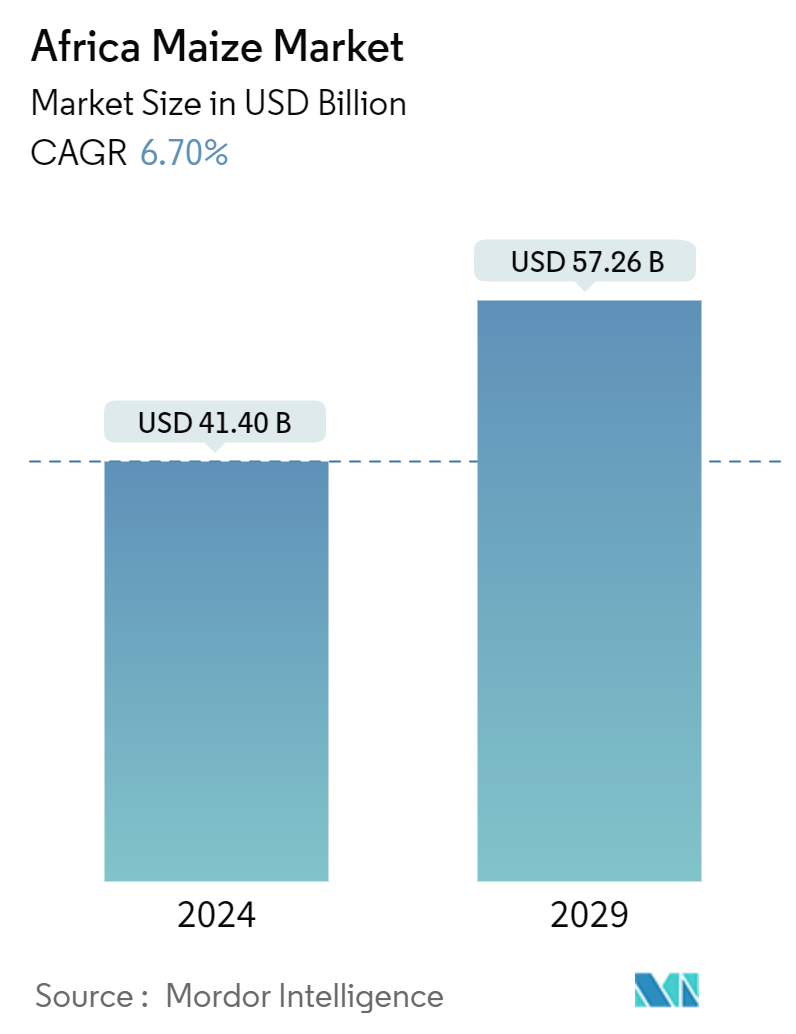Market Size of Africa Maize Industry

| Study Period | 2019 - 2029 |
| Base Year For Estimation | 2023 |
| Forecast Data Period | 2024 - 2029 |
| Market Size (2024) | USD 41.40 Billion |
| Market Size (2029) | USD 57.26 Billion |
| CAGR (2024 - 2029) | 6.70 % |
Africa Maize Market Analysis
The Africa Maize Market size is estimated at USD 41.40 billion in 2024, and is expected to reach USD 57.26 billion by 2029, growing at a CAGR of 6.70% during the forecast period (2024-2029).
Maize is considered to be the staple food for most parts of Sub-Saharan Africa. The popularity and production of maize are increasing significantly, with government aid and investments flooding the African agriculture sector. Maize is also considered a food security crop in different parts of Africa as it can be easily produced in different regions year-round according to weather conditions. It provides income for most households that depend on agriculture. The major driving factors for the increasing production are the increasing population pushing food scarcity to new highs and the increasing demand for maize from other sectors like animal feed.
Africa consumes 30% of the maize produced in the world, with Sub-Saharan Africa accounting for 21.0% of the consumption. Around 14 countries in Africa consume 85-95% of maize as their staple food and are more inclined to consume white maize, with a consumption share of around 90.0%. Thus, white maize has a premium price in the country. Most of the maize is produced in rain-fed areas. However, it is also grown in Africa's drought and famine-stricken regions.
According to the FAOSTAT, the total harvested area under maize in the region was around 42 million hectares in 2022. South Africa is the largest producer of maize in Africa, followed by Nigeria. According to the USDA reports, maize production in Africa increased by almost 8.2% in 2022 from the last 5 years, estimated to be 92.8 million metric tons. In 2021, South Africa contributed 1.34% of the global maize production, according to the USDA Foreign Agricultural Service survey.
The exports from Africa increased by 75.38% in value from 2019 to 2022 and reached USD 62.8 billion in 2022, according to the ITC trade data. Strategic trade agreements, climate-resilient crop varieties, supportive government policies, economic diversification, and technological advancements have also played crucial roles. These factors collectively boosted production and export capacity, making Africa a competitive player in the global maize market during the forecast period.
Africa Maize Industry Segmentation
Maize is one of the cereal grains commonly known as corn and is a major cereal crop grown in the region. The African maize market provides the production (volume), consumption (value and volume), and trade in terms of import (value and volume), export (value and volume), and price trend analysis of maize in Africa. The market is segmented by geography (South Africa, Ethiopia, Zambia, Nigeria, and Malawi). The report offers market estimation and forecasts in value (USD) and volume (metric tons) for the above-mentioned segments.
| Geography (Production Analysis by Volume, Consumption Analysis by Volume and Value, Import Analysis by Volume and Value, Export Analysis by Volume and Value, and Price Trend Analysis) | |
| South Africa | |
| Ethiopia | |
| Zambia | |
| Nigeria | |
| Malawi |
Africa Maize Market Size Summary
The maize production industry in Africa is poised for significant growth, driven by its status as a staple food and a critical component of food security across Sub-Saharan Africa. The crop's adaptability to various climatic conditions and its role in providing income for agricultural households underscore its importance. The increasing population and rising demand for maize in sectors such as animal feed are key factors propelling production. Africa's substantial consumption of global maize production, particularly in countries that favor white maize, highlights the crop's centrality to the region's diet and economy. South Africa leads in production, benefiting from favorable climatic conditions that enhance the quality of its maize, particularly for milling and consumer markets.
The market is further bolstered by strategic trade agreements, government support, and technological advancements, which have enhanced Africa's export capacity and competitiveness in the global maize market. The growing demand for maize as a primary ingredient in animal feed, driven by an increasing cattle population and the rising consumption of poultry, is a significant trend influencing the market. The introduction of genetically modified maize varieties in countries like Nigeria and Kenya is expected to further transform production capabilities. Additionally, maize by-products are finding diverse applications across various industries, which is anticipated to sustain and potentially increase demand during the forecast period.
Africa Maize Market Size - Table of Contents
-
1. MARKET DYNAMICS
-
1.1 Market Overview
-
1.2 Market Drivers
-
1.2.1 Increasing Demand Due to Growing Population
-
1.2.2 Increasing Application in Animal Feed
-
1.2.3 Supportive Government Policies and Subsidies
-
-
1.3 Market Restraints
-
1.3.1 Pest and Disease Infestation
-
1.3.2 Inadequate Infrastructure Leading to Post-harvest Losses
-
-
1.4 Value Chain Analysis
-
-
2. MARKET SEGMENTATION
-
2.1 Geography (Production Analysis by Volume, Consumption Analysis by Volume and Value, Import Analysis by Volume and Value, Export Analysis by Volume and Value, and Price Trend Analysis)
-
2.1.1 South Africa
-
2.1.2 Ethiopia
-
2.1.3 Zambia
-
2.1.4 Nigeria
-
2.1.5 Malawi
-
-
Africa Maize Market Size FAQs
How big is the Africa Maize Market?
The Africa Maize Market size is expected to reach USD 41.40 billion in 2024 and grow at a CAGR of 6.70% to reach USD 57.26 billion by 2029.
What is the current Africa Maize Market size?
In 2024, the Africa Maize Market size is expected to reach USD 41.40 billion.

